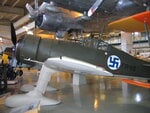- Thread starter
- #121
Hornchurch
Airman
- 38
- Jul 3, 2020
'
As it's now "onto another page", I'd like to chuck-in several rarer, more unusual period photographs for discussion.
First-off, THIS rather unusual shot, of a 109-'Emil' approaching, then over-flying The Eifel-Tower, summer 1940.
Perhaps someone would like to suggest the unit/staffel/JagdGeschwader & perhaps, maybe even the ACTUAL date ("If" they know ?)

I'll add some more (yet), so, please DO check-back, later this eve' !
Here's another superlative shot, of 32 Sqdn at dispersal/readiness, during Summer 1940
I've ALWAYS been particularly taken by their large/massive oversized 'GZ' squadron-fuselage-codes
LOVE this shot, as it has everything...... (Am also a huge fan of Pete Brothers, but he's NOT in this particular shot)

As it's now "onto another page", I'd like to chuck-in several rarer, more unusual period photographs for discussion.
First-off, THIS rather unusual shot, of a 109-'Emil' approaching, then over-flying The Eifel-Tower, summer 1940.
Perhaps someone would like to suggest the unit/staffel/JagdGeschwader & perhaps, maybe even the ACTUAL date ("If" they know ?)
I'll add some more (yet), so, please DO check-back, later this eve' !
Here's another superlative shot, of 32 Sqdn at dispersal/readiness, during Summer 1940
I've ALWAYS been particularly taken by their large/massive oversized 'GZ' squadron-fuselage-codes
LOVE this shot, as it has everything...... (Am also a huge fan of Pete Brothers, but he's NOT in this particular shot)
Last edited:

